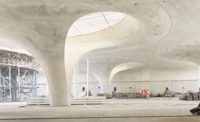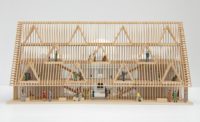At the 2019 Bundesgartenschau (BUGA), or Federal Garden Show, in Germany, the most interesting structures are built of paradox. Inspired by nature but designed and partly built by robots, the BUGA Wood Pavilion was created by the Institute for Computational Design and Construction (ICD) at the University of Stuttgart for the biennial, which takes place at a new venue every other summer. This year, BUGA is set on an island in the Neckar River, which runs through the town of Heilbronn, just over an hour south of Frankfurt. A total of 376 prefabricated, interlocking hexagonal plates make up the exoskeleton of the ultra-lightweight wood pavilion, which emulates the patterns found in sea urchin shells. Finger joints enable the larch-wood plates to be snapped together like puzzle pieces. The 98-foot-long, double-curved pavilion–with its superior acoustics and an ethereal evening glow from thousands of LEDs embedded in its interior–is a perfect host for outdoor concerts and public events. The structure will be on-site through October, after which it will be disassembled to find a new home. Monika Göbel, research associate and architect at ICD, said that one of the institute’s core tenets is to ensure that its findings are eventually represented through a constructed example in the real world, and this is a timely one, at that. “If you built these individual plates with manpower, it would take a long time and lose its efficiency.” By contrast, it took the two robots seven minutes to assemble each wood plate.
BUGA Wood Pavilion by ICD University of Stuttgart
Heilbronn, Germany

Photo © Roland Halbe







Post a comment to this article
Report Abusive Comment